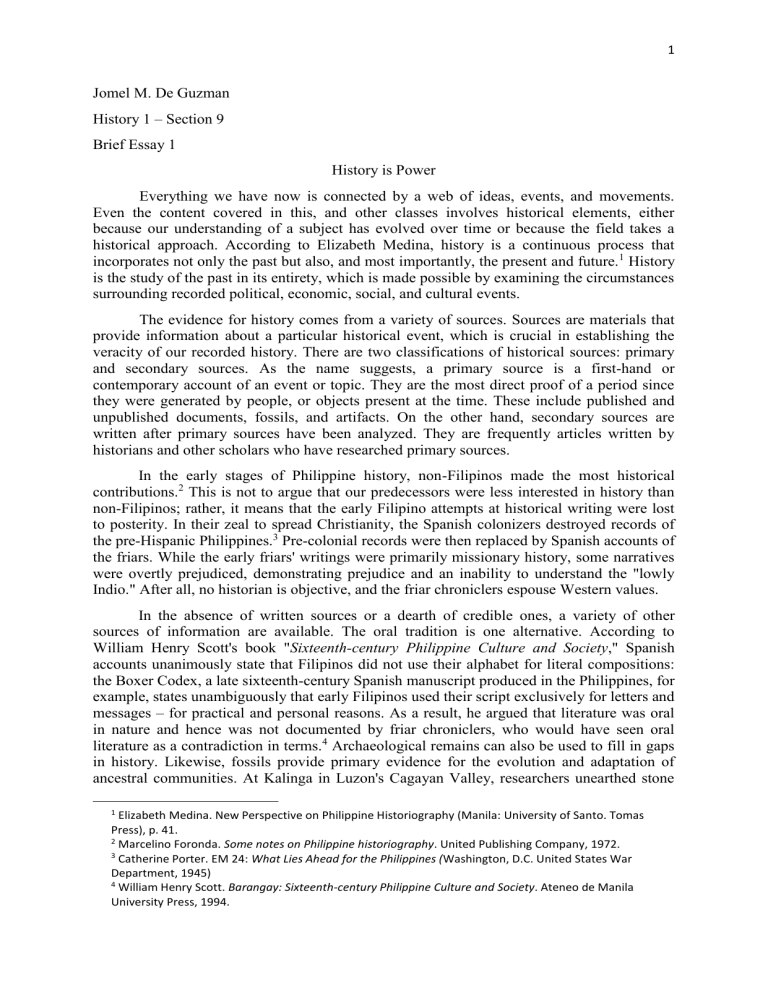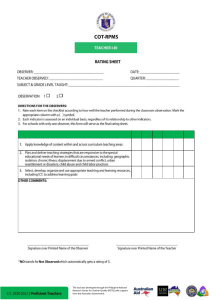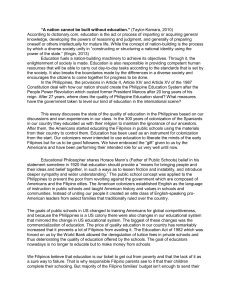
1 Jomel M. De Guzman History 1 – Section 9 Brief Essay 1 History is Power Everything we have now is connected by a web of ideas, events, and movements. Even the content covered in this, and other classes involves historical elements, either because our understanding of a subject has evolved over time or because the field takes a historical approach. According to Elizabeth Medina, history is a continuous process that incorporates not only the past but also, and most importantly, the present and future. 1 History is the study of the past in its entirety, which is made possible by examining the circumstances surrounding recorded political, economic, social, and cultural events. The evidence for history comes from a variety of sources. Sources are materials that provide information about a particular historical event, which is crucial in establishing the veracity of our recorded history. There are two classifications of historical sources: primary and secondary sources. As the name suggests, a primary source is a first-hand or contemporary account of an event or topic. They are the most direct proof of a period since they were generated by people, or objects present at the time. These include published and unpublished documents, fossils, and artifacts. On the other hand, secondary sources are written after primary sources have been analyzed. They are frequently articles written by historians and other scholars who have researched primary sources. In the early stages of Philippine history, non-Filipinos made the most historical contributions.2 This is not to argue that our predecessors were less interested in history than non-Filipinos; rather, it means that the early Filipino attempts at historical writing were lost to posterity. In their zeal to spread Christianity, the Spanish colonizers destroyed records of the pre-Hispanic Philippines.3 Pre-colonial records were then replaced by Spanish accounts of the friars. While the early friars' writings were primarily missionary history, some narratives were overtly prejudiced, demonstrating prejudice and an inability to understand the "lowly Indio." After all, no historian is objective, and the friar chroniclers espouse Western values. In the absence of written sources or a dearth of credible ones, a variety of other sources of information are available. The oral tradition is one alternative. According to William Henry Scott's book "Sixteenth-century Philippine Culture and Society," Spanish accounts unanimously state that Filipinos did not use their alphabet for literal compositions: the Boxer Codex, a late sixteenth-century Spanish manuscript produced in the Philippines, for example, states unambiguously that early Filipinos used their script exclusively for letters and messages – for practical and personal reasons. As a result, he argued that literature was oral in nature and hence was not documented by friar chroniclers, who would have seen oral literature as a contradiction in terms.4 Archaeological remains can also be used to fill in gaps in history. Likewise, fossils provide primary evidence for the evolution and adaptation of ancestral communities. At Kalinga in Luzon's Cagayan Valley, researchers unearthed stone 1 Elizabeth Medina. New Perspective on Philippine Historiography (Manila: University of Santo. Tomas Press), p. 41. 2 Marcelino Foronda. Some notes on Philippine historiography. United Publishing Company, 1972. 3 Catherine Porter. EM 24: What Lies Ahead for the Philippines (Washington, D.C. United States War Department, 1945) 4 William Henry Scott. Barangay: Sixteenth-century Philippine Culture and Society. Ateneo de Manila University Press, 1994. 2 tools and bones from a slaughtered rhinoceros that date hundreds of thousands of years before modern humans arose. Although the finding alters the story of human migration, experts are still uncertain which human species chopped the tree.5 Additionally, linguists and geneticists can infer possible movements and linkages made by early Filipinos based on commonalities in extant languages and genetic similarities in contemporary populations. The vocabulary of reconstructed proto-languages or mother languages can reveal data about the locations and lives of Philippine ancestral communities through comparative linguistics. On the likelihood that early Filipino settlements did not write their history, the Philippine oral literature and other mediums can provide information about their lives and culture. Throughout ancient times, the history of Southeast Asia was conveyed orally through a chosen storyteller.6 The stories were critically crafted in such a way that they conspicuously reflected the whole admiring community. Folklore, myths, and legends were also orally transmitted between individuals to generations. Additionally, Filipinos have represented themselves in a variety of ways, including via art. The manunggul jar, for example, displayed the Filipinos' sense of workmanship. While the jar's design, form, and body all convey stories and messages about its creators, its cover — shaped like a small boat with two passengers is its most remarkable feature. The jar reaffirms early societies' belief that after a person's physical death, his second person, or "soul," goes to the other side of life, where it may continue to exist in some form. Prior to colonial times, the Philippines was already a melting pot of regional cultures, and we can examine our oral literature and cultural elements, such as artifacts, to gain insight into the lives of early Filipinos. By enabling us to record our history, the development of writing aided in the study of history. Even then, much of what we know about the pre-Spanish to Spanish colonization period comes from other countries' records, such as Spain's Antonio Pigafetta and China's Chao-Ju Kua.7 Meanwhile, historians' reliance on secondary sources written by non-Filipinos to evaluate primary sources has hampered their ability to compile data necessary for a critical examination of early Philippine history from a Filipino perspective. We can, however, gain insight into the lives of early Filipinos by conducting extensive research using non-written sources. And, while history is frequently dismissed as impractical in comparison to other disciplines due to the intangible nature of its output, it is vital to our society. Our history profoundly influences who and what we are, it shapes our identities and instill a sense of national ideals and a commitment to national allegiance by emphasizing the richness of the national experience. Renato Constantino, a proponent of the concept of people's history, defined history as the collective struggle of the people for the full realization of freedom and liberty.8 On the other hand, Brazilian educator and revolutionary Paulo Freire stated in his book "Pedagogy of the Oppressed" that without a sense of identity, there can be no real struggle.9 Thus, history has been and will continue to be a source of power – a source of thought and action for the Filipino people. 5 Daley, Jason. “700,000-Year-Old Butchered Rhino Pushes Back Ancient Human Arrival in the Philippines | Smart News | Smithsonian Magazine.” Smithsonian Magazine. www.smithsonianmag.com. Accessed February 17, 2022. https://www.smithsonianmag.com/smart-news/butchered-rhino-puts-humanancestors-philippines-700000-years-ago-180968959/. 6 Reyes, Portia. "Pantayong Pananaw and Bagong Kasaysayan in the new Filipino Historiography. A History of Filipino Historiography as an History of Ideas." PhD diss., Universität Bremen, 2002. 7 Foronda. Notes on Philippine historiography 8 Tan, Samuel, 1993. The Methodology of Filipino Muslim History. (Philippine Social Science Encyclopedia, Vol. II). 9 Freire, Paulo, 1921-1997. Pedagogy of the Oppressed. New York :Continuum, 2000.




